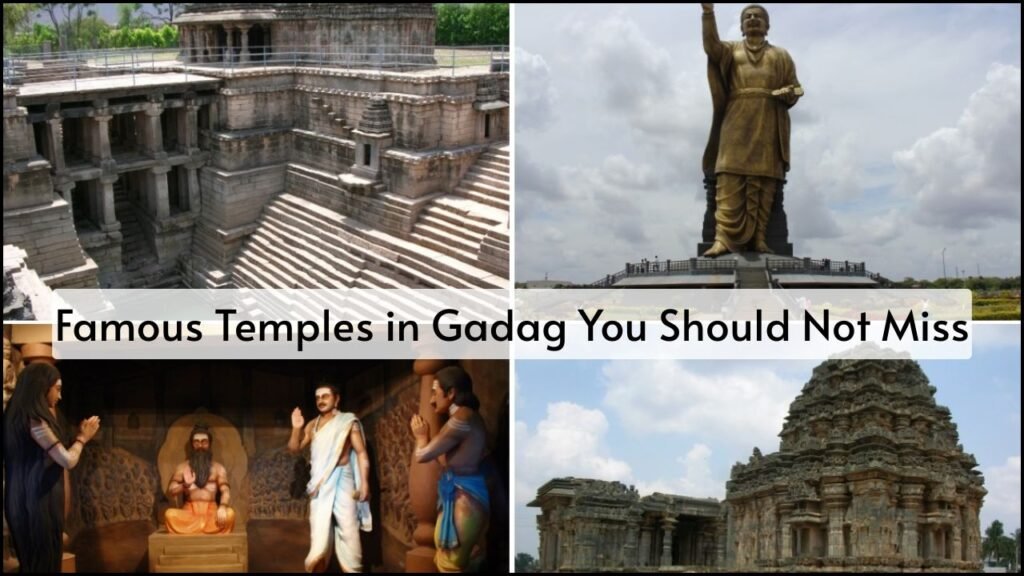
Gadag is home to magnificent temples that combine religious devotion with exquisite craftsmanship. These temples attract devotees and tourists alike, offering a window into the region’s past through sculptures, inscriptions, and architectural styles. Exploring these temples provides insights into the religious traditions and artistic achievements that have flourished here for centuries.
Table of Contents
Important Temples in Gadag
| Temple Name | Location | Architectural Style | Unique Features | Historical Period |
|---|---|---|---|---|
| Trikuteshwara Temple | Gadag Town | Western Chalukya Style | Three shrines dedicated to Lord Shiva | 11th Century |
| Veeranarayana Temple | Gadag Town | Hoysala & Vijayanagara | Large black stone idol of Lord Vishnu | 14th Century |
| Laxmi Narayana Temple | Gadag Town | Hoysala Style | Intricate carvings of gods and goddesses | 12th Century |
| Saraswati Temple | Gadag Town | Dravidian Style | Dedicated to Goddess Saraswati, beautiful pillars | 15th Century |
| Siddheshwara Temple | Near Gadag | Western Chalukya Style | Ornate pillars and sculptures dedicated to Shiva | 11th Century |
Trikuteshwara Temple
- Famous as a masterpiece of Western Chalukya architecture.
- Contains three shrines dedicated to Lord Shiva, arranged around a shared hall.
- Stone carvings depict mythological stories with artistic finesse.
- Pillars feature detailed designs showing high craftsmanship.
- The temple layout reflects advanced architectural planning.
- A must-visit for lovers of ancient Indian temple architecture.
Veeranarayana Temple
- Dedicated to Lord Vishnu.
- Blends Hoysala and Vijayanagara architectural elements.
- Houses a large black stone idol of Vishnu in a standing posture.
- Spacious hall supported by intricately carved pillars.
- Hosts festivals that attract many devotees.
- Sculptures display fine attention to detail and artistic skill.
Laxmi Narayana Temple
- Known for intricate carvings of Hindu gods and goddesses.
- Built on star-shaped platforms, typical of Hoysala architecture.
- Walls and roof decorated with small sculptures narrating Hindu myths.
- Dedicated to Lord Vishnu and Goddess Lakshmi, symbols of prosperity.
- Visitors admire the temple’s peaceful atmosphere and artistic beauty.
Saraswati Temple
- Honors Goddess Saraswati, the deity of knowledge and wisdom.
- Exhibits Dravidian architectural style with tall, sculpted pillars.
- Pillars and roof designs are richly detailed.
- Popular among students and artists seeking blessings.
- Decorated with sculptures of swans and musical instruments.
- Hosts cultural events and traditional music performances.
Siddheshwara Temple
- One of the oldest temples near Gadag.
- Built in the Western Chalukya style.
- Dedicated to Lord Shiva with ornate pillars and detailed sculptures.
- Features artistic representations of Shiva in multiple forms.
- Outer walls depict scenes from Hindu scriptures.
- Offers a serene environment for meditation and worship.
Architectural Significance of Gadag Temples
| Feature | Description |
|---|---|
| Stone Carvings | Highly detailed sculptures on pillars and walls |
| Multi-Shrine Layout | Temples like Trikuteshwara have several shrines |
| Pillars and Mandapas | Spacious halls supported by decorated pillars |
| Mythological Sculptures | Stories from epics carved in stone |
| Use of Soapstone | Soft stone used for delicate, intricate carving |
| Star-Shaped Platforms | A hallmark of Hoysala architectural style |
- The temples reflect deep knowledge of engineering and artistry.
- Soapstone enabled craftsmen to carve fine details that have lasted centuries.
- Symmetrical designs and multiple shrines show diversity in worship.
- Pillars and halls serve as both structural elements and canvases for art.
- These features make the Gadag temples important for historical and architectural studies.
Festivals and Religious Activities
| Temple | Major Festivals | Special Events |
|---|---|---|
| Trikuteshwara Temple | Maha Shivaratri | Night-long prayers and cultural shows |
| Veeranarayana Temple | Vaikuntha Ekadashi | Special poojas and community feasts |
| Laxmi Narayana Temple | Diwali | Lighting ceremonies and rituals |
| Saraswati Temple | Vasant Panchami | Educational and cultural programs |
| Siddheshwara Temple | Shravan Month | Daily abhishekam and special offerings |
- Temples serve as centers for vibrant cultural and religious activities.
- Maha Shivaratri and Diwali bring large gatherings and celebrations.
- Rituals, music, dance, and community meals enhance social bonds.
- Saraswati Temple is significant during Vasant Panchami for blessings in education.
- Festivals help preserve ancient traditions and encourage community participation.
Visitor Information
| Temple | Visiting Hours | Entry Fee | Best Time to Visit | Facilities Available |
|---|---|---|---|---|
| Trikuteshwara Temple | 6:00 AM – 8:00 PM | Free | October to March | Parking, guides, toilets |
| Veeranarayana Temple | 7:00 AM – 7:00 PM | Free | November to February | Clean drinking water, guides |
| Laxmi Narayana Temple | 6:30 AM – 8:00 PM | Free | October to March | Rest area, information center |
| Saraswati Temple | 8:00 AM – 6:00 PM | Free | January to March | Parking, cultural event support |
| Siddheshwara Temple | 6:00 AM – 7:00 PM | Free | July to September | Toilets, parking |
- Temples offer convenient visiting hours for early morning or evening visits.
- Entry is free, encouraging spiritual tourism.
- Cooler months and festival times are ideal for visits.
- Facilities such as parking, drinking water, guides, and rest areas enhance visitor comfort.
Key Takeaways
Spiritual energy and artistic beauty make Gadag’s temples worthy destinations for anyone interested in heritage and faith.
Gadag temples represent a unique blend of spirituality, art, and history.
Each temple tells stories carved in stone and keeps alive rituals linking past and present.
The architectural brilliance showcases the skills of ancient craftsmen and the region’s cultural richness.





